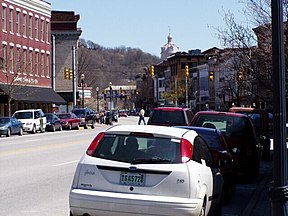Madison Historic District (Indiana)
| Madison Historic District | ||
|---|---|---|
| National Register of Historic Places | ||
| Historic District | ||
| National Historic Landmark | ||
|
Main Street |
||
|
|
||
| location | Madison in Jefferson County , Indiana | |
| Coordinates | 38 ° 44 '32 " N , 85 ° 22' 38" W | |
| NRHP number | 73000020 | |
| The NRHP added | May 25, 1973 | |
| Declared as an NHL | March 20, 2006 | |
The Madison Historic District is a listed building located in Madison , Jefferson County , Indiana . As such, it was declared a National Historic Landmark in 2006 because of its unique beauty and typical Midwestern architecture . Prominent structures within the district include the Lanier Mansion and Charles L. Shrewsbury House , both classified as National Historic Landmarks, and Schofield House , considered the birthplace of the Grand Lodge of the Masonic Indianas. It includes a total of 133 blocks in Madison. These are elevated above the Ohio River .
The Lanier Mansion was the former domicile of James Lanier , whose finances enabled the then Governor Oliver P. Morton to run the Indian government from 1862 to 1865 bypassing the legislative process. Shrewsbury House was built for combat captain Charles Shrewsbury, who was later elected mayor of the city. Francis Costigan was the architect of the house, which is considered one of the best buildings on a narrow lot by a modern architect and whose drawing room is the highlight of the house.
Many of the better-known structures in the district were built by the Madison-born Costigan. This favored the neoclassical architectural style.
Madison experienced its heyday before 1860. The city was a traffic junction where goods transported on ships were transshipped and transported into the interior of Indiana. When the Madison & Indianapolis Railroad was built in 1835 , Madison was much larger than Indianapolis , the then new capital of the state. The railway line was built mainly by construction workers from Ireland. As the transportation routes changed, Madison's glory faded until a century later the tourism industry saved the city from further decline.
Madison was also an important stop on the Underground Railroad , as residents of many homes were once involved in helping slaves freedom.
The Historic District was listed as a Historic Monument on May 25, 1973 with the number 73000020 on the National Register of Historic Places .
gallery
Web links
Individual evidence
- ↑ Phyllis Thomas: Indiana: Off the Beaten Path: a Guide to Unique Places ( English ). Globe Pequot, 2007, p. 152 (accessed February 15, 2011).
- ↑ Listing of National Historic Landmarks by State: Indiana. National Park Service , accessed July 22, 2019.
- ↑ Walking Tour of Historic Madison, Indiana ( English ). Madison Area Convention & Visitors Bureau (MACVB),, p. 6.
- ↑ MACVB, pp. 7-8.
- ↑ Historic homes and buildings of Madison, IN ( English ) Retrieved on February 15 2011th
- ↑ O'Guinn, S. 112th
- ^ Fife, Camille B .: National Historic Landmark Nomination: Madison Historic District ( English , PDF; 2.1 MB) National Park Service. October 2003. Retrieved on February 15, 2011. and associated images (PDF; 22 kB)
- ^ Madisonview ( English ) Retrieved February 15, 2011.
- ↑ Helen O'Guinn: Day Trips from Indianapolis ( English ), 2nd edition, Globe Pequot, 2004, p 111th
- ^ Madison Historic District on the National Register Information System. National Park Service , accessed August 27, 2017.





